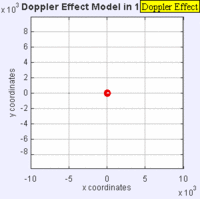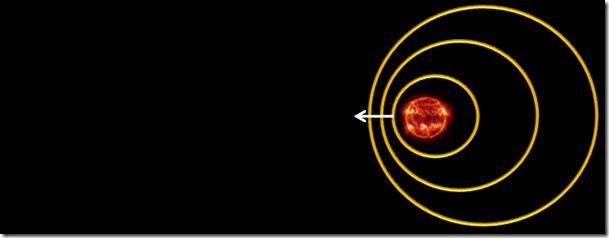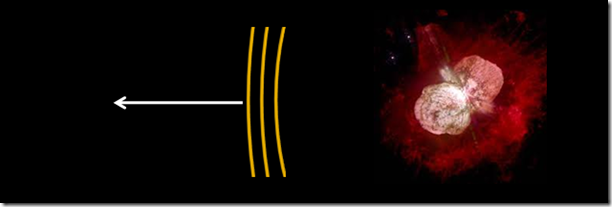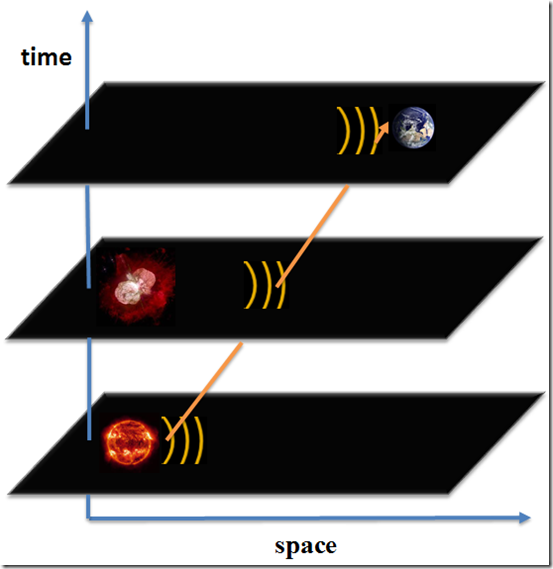Previous puzzle: Puzzle Piece 4: The (other) Heisenberg
The Doppler effect for sound is very simple of course, and you surely know how it works. And I am sure you also think it is easy for light, but unfortunately, due to the way that “mainstream physics” interprets relativity, the whole thing gets very strange for light. However, if we consider the “elastic solid” interpretation of relativity, than the entire mystery vanishes, and what is left is the same explanation as for sound. To see what the issue is, let’s first take a detailed look at the Doppler effect for sound:
Doppler Effect for Sound:
Let’s first consider what sound is: 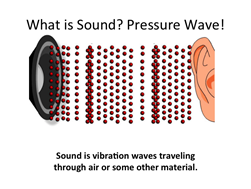
it is a pressure wave that moves through a medium such as air. When a sound is emitted, the sound wave travels at a fixed speed (assuming no wind) through the medium. Once the sound is emitted, it exists whether the speaker disappears afterwards or if there is no listener (you will see why I write such a weird thing later).
Let’s take a look at the stationary case: imagine a speaker in a room that emits sound of a particular frequency (such as 440hz) (from Wikipedia)
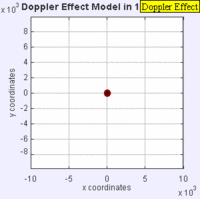 The sound spreads in all directions, at the speed of sound.
The sound spreads in all directions, at the speed of sound.
Now imagine the speaker is moving to the right. The speed of sound never changes, so the waves always spread at the same speed. But now, because the speaker is moving, the pressure waves are closer together in the moving direction, because the speaker is moving relative to the medium. If we plot the frequency on top of the waves, then you can see clearly that the frequency is higher in the moving direction, and lower behind the speaker.
The exact same effect happens if there is a microphone (an observer) that is moving towards the waves, relative to the medium. Note I said towards the waves, not towards the speaker. We can destroy the speaker or move it after it emitted the sound, but the sound waves are still in the air and moving no matter what the speaker does afterwards. What matters is how the microphone moves relative to the medium, and what pressure waves it records. If the microphone moves towards the waves, it will observe more pressure waves than if it is moving away.
The total shift depends on the speed of the speaker and also on the speed of the observer (relative to the medium!). The general formula is:

If vr and vs are small relative to the speed of the wave c, then this can be simplified to:

Where 
Doppler Effect for Light:
The formula for light is exactly the same (for non-relativistic speed):

Below is an interactive animation (click on it) where you can play with the Doppler effect for light. It really shows how the effect actually works in reality. However, as you will see shortly, this contradicts the “mainstream” interpretation.
Clearly, since light is also a wave, and since the formula is also the same, it is logical that the mechanism for light is also the same. So what is the issue here? If you have read the other posts, then you know that there are two interpretations of relativity. The space-time interpretation, which is the mainstream one, and the elastic solid interpretation of space (Hagen Kleinerts World Crystal).
The animation above actually corresponds more to the elastic solid interpretation than the mainstream interpretation: in this model, just as with sound, the light waves are nothing more than oscillations in an absolute space. Once the star has emitted light, the light continues to exist and travel no matter what the star does: in the image below, a star that is moving to the left is emitting light. At that time, earth does not exist yet (say the star is 6 billion light years away from (future) earth).
If the star explodes as a super nova, it doesn’t matter. The light that was emitted before still continues to travel through space, no matter if it will ever be “observed” or not. Just think of all the supernovas that have been observed already millions of light years a away. By the time the light reaches earth, the super nova is long gone! The source is no longer there:
Similar in other cases: if the start has emitted light and was moving, then by the time the light reaches earth, it might be on the other side of the galaxy… The light we observe from stars is independent of the existence of the star. I know it sounds like I am beating a dead horse, but there are people who seriously claim otherwise.
The frequency that the light has in space depends on the velocity that the star had at the time the light was emitted – just like with the speaker example above. And when the light is observed, say on earth, the frequency may be shifted a second time, depending on how earth is moving relative to space (and not relative to the star – which may be been gone by now!),:
The problem is that based on the “space time” interpretation, there is no absolute space, so there is no medium at all through which light can propagate. The question then is, how would a Doppler effect in that case even be possible? If there really is no “space” (no medium), then at the time light is emitted by a moving star, and if there is no observer yet (no earth), then there should be no frequency shift at all, since the star is not really moving at all if there is no absolute space. So what frequency will the light have? There is no explanation as how it could possibly be red or blue shifted if there were no space, as there is no mechanism, no medium where this change of frequency could occur. If you ask a mainstream physicist, most likely you will get a space-time diagram, that shows the source and observer in the same image:
This may look nice, but it doesn’t change the fact that the first frequency shift happens at the time that the light waves are emitted from the star, and that at each point in space (and time), the light wave exists, and has a well defined frequency – which can only be true if some kind of “space” exists. Just because we can draw a line from the past to the present does not somehow change this problem. At the time the light waves were emitted, the star did not “’know” that one day earth will come into existence and will measure its rays… so it cannot depend on the (future) observer…. So based on this model, there can never be any frequency shift at the time the light is emitted. The line from the past to the present, and using the relative speed between source and observer is just a mathematical trick, and says nothing about the underlying reality.
So you have two choices:
a) believe that space exists in an absolute sense (the red pill). Then the Doppler effect of light is explained exactly the same way as it is for sound – no magic involved, it’s totally simple.
b) believe that no space exists in an absolute sense (the blue pill). Then the Doppler effect can only be explained by some magic between the source and (future) observer… where the light wave does not really exist until measured, and one cannot even talk about a frequency of the light wave on its own. There is no physical explanation of all of this, just a mathematical formula (and a nice space-time diagram that looks complicated).
Interestingly tough, most of them will admit that we are in fact moving relative to the cosmic microwave background (CMB), as it clearly shows a Doppler effect (an anisotropy):
It is even possible to compute the speed of earth relative to the universe that way, and it is on the order of 600km/s (which includes the movement of earth around the sun, the sun around the galaxy, and the movement of the milky way itself relative to the cosmos).
So I wonder, if maybe the idea of an absolute space is not so absurd after all?
Next puzzle: Puzzle Piece 6: Disentangling the Entanglement
Summary Table
Space-density Universe
|
Space-Time Universe
|
|
| Tags | elastic solid, crystal universe, optical-mechanical analogue, space exists | Minkowski, space-time, absolute space does not exist |
| GR Metric Tensor | space-density (space with compression) | space-time |
| Cause of Gravity | refraction (density gradient, optical) | curvature of space-time |
| Photon | quantized wave, similar to phonon quasiparticles in crystal (vibrational mode), there are no photon “particles” | probability density wave function, no “real” wave, probability of finding photon |
| Double Slit Experiment | real waves interfering (like phonons) | parallel universes, no real wave, “consciousness” ,probabilistic… |
| Schrödinger Wave Equation | describes real waves, rotational waves in an elastic solid. There are no particles | probability of finding a particle, there are no real waves |
| What is space? | An elastic solid (not made of matter). Matter and light moves though space as waves move through a crystal | There is no absolute space |
| Special Relativity | Time dilation and length contraction are consequence of any wave system. Any wave has a maximum speed in any given medium. | There is no intuitive explanation. It follows from the constancy of the speed of light for each observer |
| Speed of light | c, constant in absolute space. Also c for each observer, due to time dilation | c is constant for each observer. There is no absolute space |
| Twin Paradox | No paradox. Whoever moved slower relative to absolute space ages faster. | If A is considered to be at rest, B ages more slowly, and vice versa. There is no clear answer as to who ages faster (if cleverly engineered –see post on that) |
| Uncertainty Principle | Natural consequence of any wave system | Due to wave property of matter and light (but only probabilistic) |
| Doppler Effect | Same as sound. Shift depends of speed of source and observer relative to an absolute space | Not same as sound as there is no medium. Strictly depends on relative velocity between observer and source. No physical explanation. |
Links
Doppler Effect:
- Wikipedia: http://en.wikipedia.org/wiki/Doppler_effect
- Wikibooks: http://en.wikibooks.org/wiki/A-level_Physics_(Advancing_Physics)/Doppler_Effect
- Animation for light: http://www.acs.psu.edu/drussell/Demos/doppler/doppler.html
- Interactive Demo: http://highered.mcgraw-hill.com/olcweb/cgi/pluginpop.cgi?it=swf::800::600::/sites/dl/free/0072482621/78778/Doppler_Nav.swf::Doppler%20Shift%20Interactive
- Mathpages: http://mathpages.com/rr/s2-04/2-04.htm
- Cosmic Microwave Background Dipole Anisotropy: http://www.astro.ucla.edu/~wright/CMB-dipole-history.html
Optical analogues of General Relativity:
- Hagen Kleinerts World Crystal:
http://users.physik.fu-berlin.de/~kleinert/papers/planckklcZN.pdf - Defects and Diffusion in the Planck-Kleinert Crystal:
http://ceram.agh.edu.pl/~icmmagh/artykuly/237%20PLANCK%20CRYSTAL%20DSL%20final.pdf - Emerging Gravity from Defects in World Crystal:
http://www.sbfisica.org.br/bjp/files/v35_359.pdf - De Felice, F. On the gravitational field acting as an optical medium. Gen. Relativ. Gravit. 2,347–357 (1971).
- On the optical-mechanical analogy in general relativity: http://arxiv.org/abs/0905.4479 ,
http://www2.ups.edu/physics/faculty/evans/Optical%20Mechanical%20GRG.pdf - The Classical Wave Theory of Matter by Robert Close: http://www.verumversa.com/
